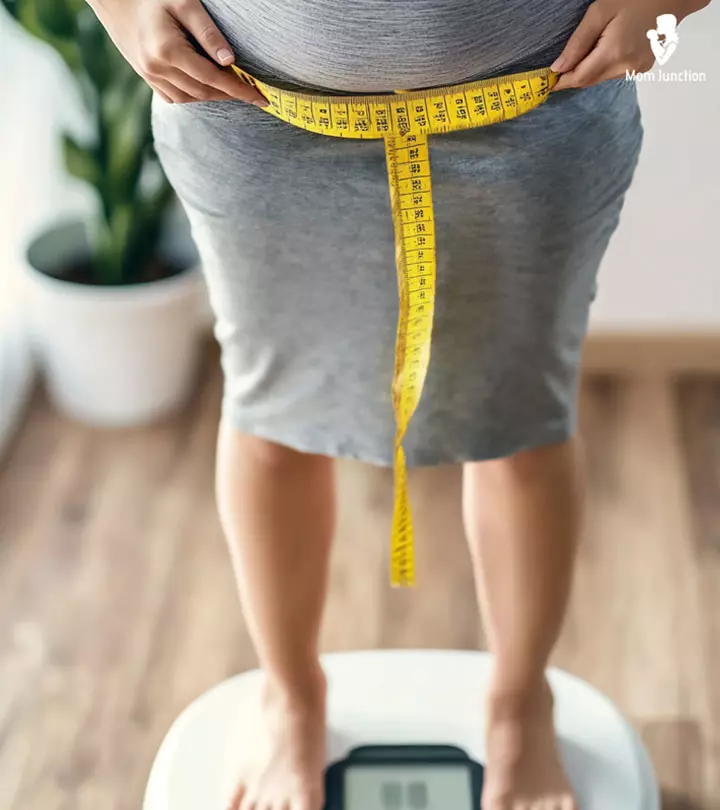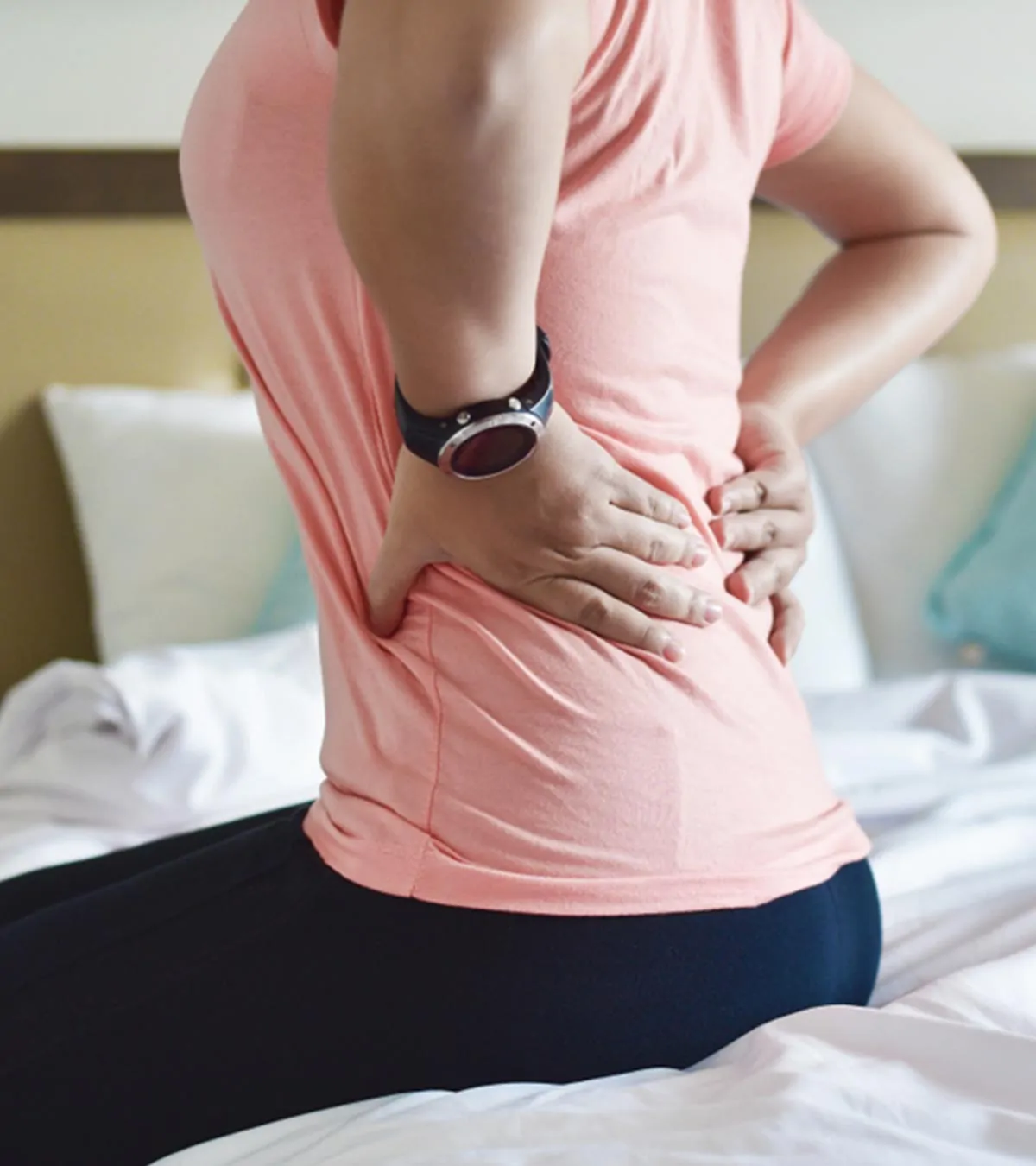
Image: Shutterstock
Back pain while breastfeeding is common during the initial days when the newborn requires feedings every one to three hours (1). Frequent feedings and recent delivery can be quite taxing for the new mother and often strain their back. As a result, many lactating mothers seek medical care for back pain that worsens or becomes chronic over time. Back pain during lactation could also affect your ability to bond with your baby. However, taking corrective measures, trying specific breastfeeding positions, and doing gentle exercises may help soothe your back. These measures can also help prevent the pain from becoming chronic.

Read this post to learn about some tips to avoid and manage back pain while breastfeeding.
Key Pointers
- Lack of sleep, improper postures while feeding, and postpartum muscle aches could lead to back pain while breastfeeding.
- Maintaining the right posture, trying simple exercises for back, shoulder, and hand stretching may ease the pain.
- Easy yoga exercises like the cat and cow pose and child pose help relax the back muscles.
- Make sure to follow a comforting breastfeeding position like the cradle position or the football hold to prevent chronic back pain while breastfeeding.
What Causes Back Pain While Breastfeeding?
It is common for a backache to occur during breastfeeding. The following reasons and factors could contribute to it.
- Poor breastfeeding posture: Improper posture while breastfeeding, certain breastfeeding positions, and tending to the infant is often a leading cause of back pain (2). Frequent slouching while breastfeeding or stooping down could cause painful back muscles. Lifting, carrying, and placing the baby repeatedly could also lead to backache.
- Postpartum muscle pain: Back pain during breastfeeding could be a remnant of pregnancy pain. Pregnancy hormones, such as relaxin, relax the muscles and loosen the ligaments and joints for childbirth. However, relaxed muscles could become easily strained and painful, especially due to the added weight of the baby (3). The pain may persist during the postpartum phase and could be compounded by the strain caused by C-section and natural delivery on the abdominal and pelvic muscles.
- Postpartum muscle problems: Certain muscle-related issues, such as postpartum muscle separation (diastasis recti) and pelvic floor muscle impairment, may also lead to back pain.
- Lack of sleep: According to research, mothers who sleep less than five hours a night, six months postpartum, are three times more likely to retain the pregnancy weight or even gain more weight (4). It could be a contributing factor to back pain while breastfeeding.
 Quick fact
Quick factWays To Relieve Back Pain While Breastfeeding
The following tips and practices may help relieve and prevent back pain while nursing.
- Maintain a correct posture. A poor posture brings a lot of added stress to the lower back. Most cases of back pain will resolve once the nursing posture is improved.
- Use supportive pillows under the lower back to get additional support. You may also use comfortable nursing and feeding pillows to relieve your arms and back from extra weight.
- Follow the principles of correct positioning and attachment when offering the breast. Consider a biological nurturing or a laid-back breastfeeding position.
- Try to sleep whenever the baby sleeps. Stress and fatigue are often responsible for back pain. Adequate rest can relieve backache and also help in better postpartum recovery.
- Try slow walking after getting the doctor’s approval. Walking is a safe exercise, and you may even do it while taking the baby outdoors for a stroll. Remember to take your doctor’s permission and ask them about the safe intensity and duration of walking for you.
- Mild exercise on the doctor’s advice can help you strengthen your muscles. Each body and pregnancy is different. Therefore, ask your healthcare provider about your recovery status and the exercise plan that would suit you the most.
- Hot compressions alleviate muscle pain. You may use a heating pad during or after a nursing session to get relief from back pain.
- Take the help of family members to care for your baby. Delegate certain tasks, such as changing the baby’s diapers, to your partner so that you can have less strain. In cases of severe back pain, express your breast milk and ask a family member to feed it to the baby with a bottle.
- Take a relaxing massage therapy to alleviate the pain after consulting about the safety of it with your doctor.
- If you plan to breastfeed while sitting on a chair, choose the right chair that provides sturdy support for your arm and back and is neither too high nor low. A pillow or two behind your back can also help make the chair more comfortable for breastfeeding (5).
You may also consider consulting a physiotherapist or a chiropractor to relieve your back pain. However, visit your healthcare provider first to know whether your postpartum recovery is suitable for further back pain treatment.
 Quick tip
Quick tipExercises For Lactating Mothers To Relieve Back Pain
You may consider gentle exercises after your ob/gyn permits. These exercises can reduce discomfort and strengthen your muscles, making them less prone to strain and pain (6) (7) (8).
1. Cat cow pose
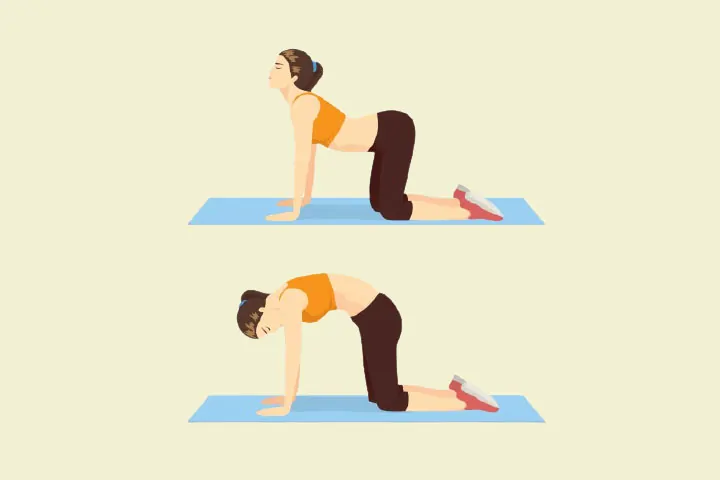
Steps:
- Kneel on the mat with your palms flat on the mat. Maintain the knees and feet at hip-width apart.
- Begin with the cow pose by breathing in and letting the stomach drop. Lift the chest and chin up while fixing the gaze towards the ceiling. Broaden your shoulders by pulling them slightly backward.
- Move to the cat pose by exhaling and retracting the stomach towards the spine.
- Round up your back and drop your head towards the floor.
- Alternate between the two poses eight to ten times.
Benefits:
- Reduces the tension in the spine by opening up the chest
- Stretches the muscles of the back, shoulders, and abdomen
- Improves blood circulation to the spine
2. Child pose

Steps:
- Sit on a yoga mat with your hips on your heels. Bend the torso forward and lower your forehead towards the floor.
- Keep arms extended and stretched in the front. Extend your head forward to touch your forehead to the floor.
- Gently press your chest against the thighs.
- Hold for 15-20 seconds, gradually uncurl the spine, and sit back on your heels.
- Repeat the pose eight to ten times.
Benefits:
- Relaxes the back
- Stretches and strengthens back muscles
- Calms down the nervous system
- Aids in digestion by relieving constipation
3. Downward facing dog

Steps:
- Come to the floor on all fours.
- Keep your hands at shoulder-width apart and feet at hip-width apart.
- Press the hands to the ground, lift the hips, straighten your knees and elbows, and extend your tailbone and form an inverted ‘V’ shape.
- Hold the pose for 15-20 seconds and take deep breaths.
- Exhale, bend your knees, and come back to the neutral position.
- Repeat the pose eight to ten times.
Benefits:
- Lengthens the spine
- Tones muscles of the upper body
- Strengthens chest muscles and increases lung capacity
- Strengthens arms, shoulders, legs, and feet
4. Standing forward bend
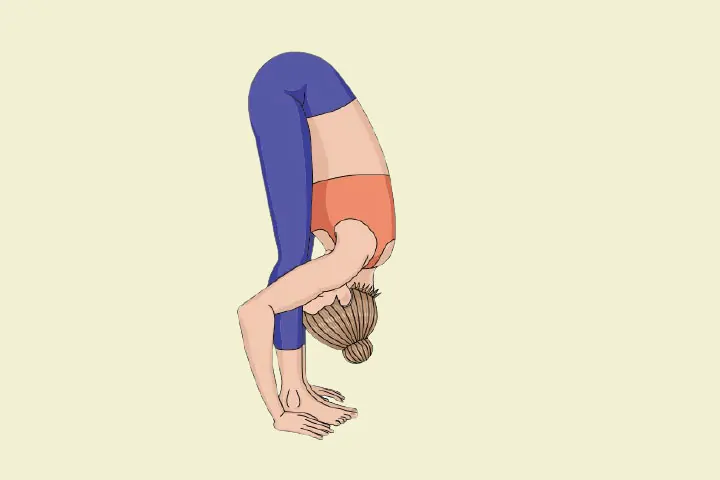
Steps:
- Stand straight with feet together and arms on the sides of the body.
- Inhale and extend your arms above your head.
- Exhale and bend forward towards your feet.
- Keep your palms on the floor, besides the feet, or on the legs.
- Hold the position for 15-20 seconds and continue breathing.
- Keep the legs and spine erect.
- Inhale, stretch the arms towards the front, and come back to the starting position.
Benefits:
- Stretches all muscles at the back of the body
- Strengthens the spine
- Improves blood circulation
5. Shoulder stretch
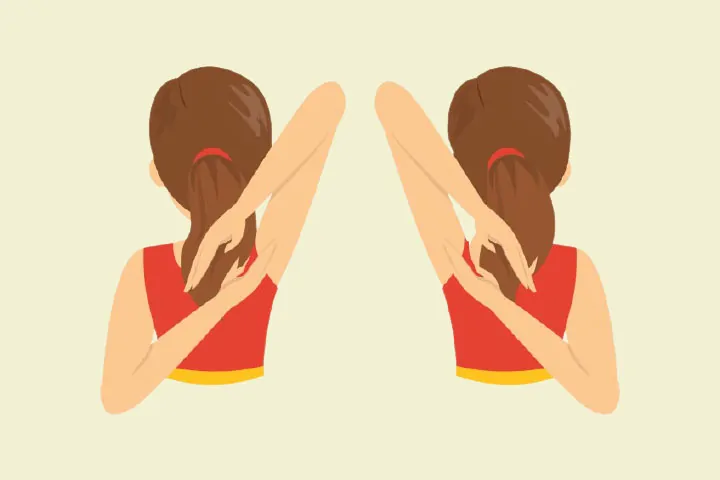
Steps:
- Position the right arm above the shoulder and behind your back.
- Hold the right hand’s fist with the left hand’s fist at the back.
- Gently stretch your upper back and shoulders backward while opening the chest. Hold the position for a few seconds.
- Gently bring the hands back to their usual position.
- Repeat the steps again with the left arm extended behind your back.
- Keep inhaling and exhaling throughout the exercise.
Benefits:
- Helps reduce upper back and neck tightness
- Strengthens neck and back muscles
6. Towel stretch
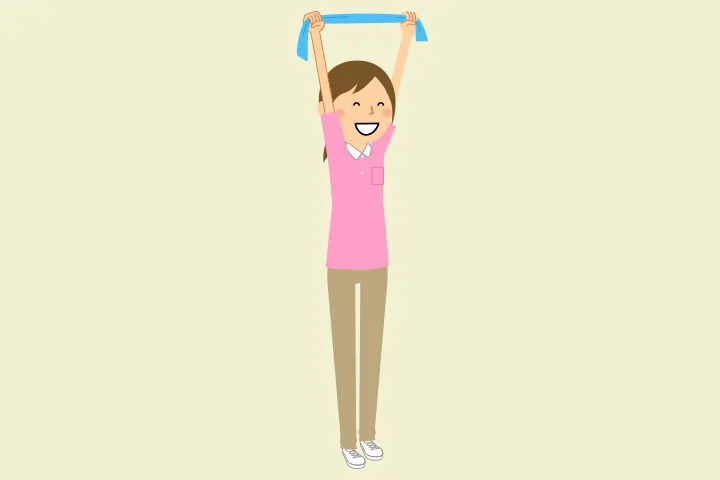
Steps:
- Hold a towel in your hands and extend your arms wider than the shoulder width.
- Keep your legs at hip-width apart.
- Inhale and raise your hands above the head. Exhale and bring them to your front.
- Inhale and take your hands above the head again, and exhale and bring them to the front. Repeat the steps 10-15 times.
Benefits:
- Strengthens arms, shoulders, and back muscles
- Stretches your shoulders, back, and neck muscles
 Quick tip
Quick tipBreastfeeding Positions To Help Avoid Back Pain
A correct breastfeeding position could help the mother prevent problems, such as back pain and sore nipples. You may consider the following feeding positions for optimum comfort.
- Cradle position
- Cross-cradle position
- The football hold
- Laidback or reclined position/ biological nurturing
- Side-lying breastfeeding position
Every mother and baby is unique, so try different positions to learn what works best for you and your baby.
Frequently Asked Questions
1. Can I use back pain patches while breastfeeding?
Painkillers are available in patches or tablets and may not be recommended for breastfeeding women. It is important to consult your doctor about taking painkillers when breastfeeding and exploring alternative, safer treatments (9) (10).
2. Are body aches normal during breastfeeding?
Yes, body aches and soreness after childbirth is normal for a few months. At the same time, pelvic girdle pain may continue for several years. Although these body aches are common in the postpartum or breastfeeding period, they may also occur from a breast infection. Hence, any pain should be consulted with a doctor (11).
3. What is laid-back breastfeeding?
Laid-back breastfeeding is the term used to describe the breastfeeding posture where the mother is reclined back with back support in a relaxed position while feeding her baby (12). This position is one of the most comfortable ones and may help reduce the risk of breastfeeding-induced back pain.
Back pain while breastfeeding is quite common. This postpartum recovery period is often stressful for the mother due to lack of sleep and frequent feeding requirements. In addition, physiological changes in muscles and ligaments during pregnancy and childbirth may be responsible for initiating back pain. Proper nursing positions can resolve most aches and pains. However, after consulting your doctor, you may try slow walking and light exercises or yoga such as shoulder stretch, child pose, and cat and cow pose.
Infographic: Preventing Back Pain While Breastfeeding
Back pain is one of the most common problems a new mother experiences when breastfeeding. Nevertheless, following some interventions, such as those detailed in this infographic, can help alleviate back pain and discomfort when nursing your baby.
Some thing wrong with infographic shortcode. please verify shortcode syntax
Illustration: Back Pain While Breastfeeding: Causes And Tips To Relieve It

Image: Stable Diffusion/MomJunction Design Team
Having a baby and breastfeeding can cause mid-back pain. Learn how to manage this pain and get relief in this helpful video.
References
1. How Much and How Often to Breastfeed; CDC
2. Overcoming Postpartum Pain; Cedars-Sinai
3. Back Pain in Pregnancy; Brigham and Women’s Hospital
4. Why Am I Gaining Weight After Giving Birth?; University of Utah
5. Positions For Breastfeeding; Healthy Children
6. Child Pose (Shishuasana); Art of Living
7. AdhoMukhaSvanasana(Downward Facing Dog) Yoga Pose; Art of Living
8. Standing Forward Bend (Hastapadasana); Art of Living
9. What are painkillers and NSAIDS; Versus Arthritis
10. Lidocaine; Mother To Baby
11. Cecilia Bergström et al. (2017); Prevalence and predictors of persistent pelvic girdle pain 12 years postpartum; BMC
12. Laid-back breastfeeding: benefits and uses; NCT
13. 7 Ways To Help With Back Pain From Breastfeeding; MILKOLOGY
Community Experiences
Join the conversation and become a part of our nurturing community! Share your stories, experiences, and insights to connect with fellow parents.
Read full bio of Regina Kincaid
Read full bio of Dr. Ritika Shah
Read full bio of Swati Patwal
Read full bio of Ghazia Shah










